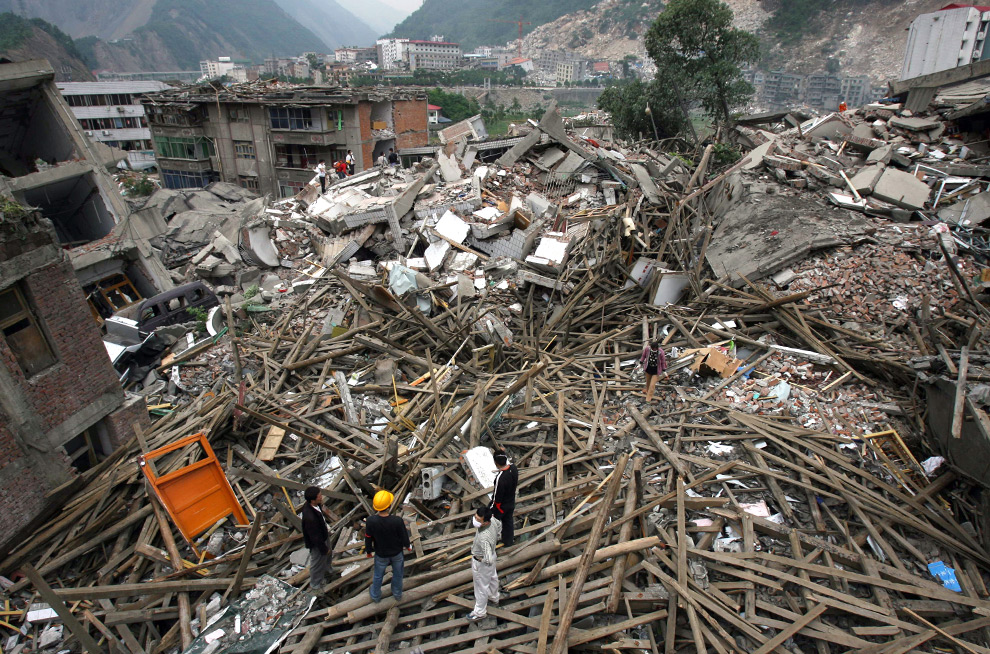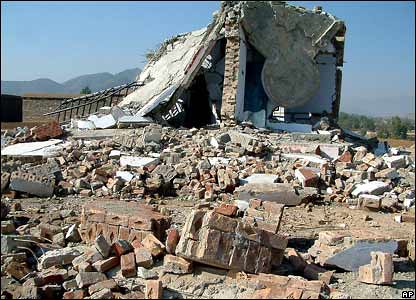It is also known as the Wenchuan earthquake (Chinese: 汶川大地震; pinyin: Wènchuān dà dìzhèn), after the location of the earthquake's epicenter, Wenchuan County in Sichuan province. The epicenter was 80 kilometres (50 mi) west-northwest of Chengdu, the capital of Sichuan, with a focal depth of 19 kilometres (12 mi). The earthquake was also felt in nearby countries and as far away as both Beijing and Shanghai—1,500 kilometres (932 mi) and 1,700 kilometres (1,056 mi) away—where office buildings swayed with the tremor.
Strong aftershocks, some exceeding magnitude 6, continued to hit the area even months after the main quake, causing new casualties and damage.
On November 6, 2008, the central government announced that it will spend 1 trillion yuan (about $146.5 billion) over the next three years to rebuild areas ravaged by the earthquake. (See also, China economic stimulus program.)
The earthquake had a magnitude of 7.9 Ms and 7.9 Mw. The epicenter was in Wenchuan County, Ngawa Tibetan and Qiang Autonomous Prefecture, 80 km west/northwest of the provincial capital city of Chengdu, with its main tremor occurring at 14:28:01.42 CST (06:28:01.42 UTC), on Monday May 12, 2008 lasting for around 2 minutes, in the quake almost 80% of buildings were destroyed.
According to a study by the China Earthquake Administration (CEA), the earthquake occurred along the Longmenshan fault, a thrust structure along the border of the Indo-Australian Plate and Eurasian Plate. Seismic activities concentrated on its mid-fracture (known as Yingxiu-Beichuan fracture). The rupture lasted close to 120 sec, with the majority of energy released in the first 80 sec. Starting from Wenchuan, the rupture propagated at an average speed of 3.1 kilometers per second 49° toward north east, rupturing a total of about 300 km. Maximum displacement amounted to 9 meters. The focus was deeper than 10 km.
In a United States Geological Survey (USGS) study, preliminary rupture models of the earthquake indicated displacement of up to 9 meters along a fault approximately 240 km long by 20 km deep. The earthquake generated deformations of the surface greater than 3 meters and increased the stress (and probability of occurrence of future events) at the northeastern and southwestern ends of the fault. On May 20, USGS seismologist Tom Parsons warned that there is "high risk" of a major M>7 aftershock over the next weeks or months.
Japanese seismologist Yuji Yagi at the University of Tsukuba said that the earthquake occurred in two stages: "The 155-mile Longmenshan Fault tore in two sections, the first one ripping about seven yards, followed by a second one that sheared four yards." His data also showed that the earthquake lasted about two minutes and released 30 times the energy of the Great Hanshin earthquake of 1995 in Japan, which killed over 6,000 people. He pointed out that the shallowness of the epicenter and the density of population greatly increased the severity of the earthquake. Teruyuki Kato, a seismologist at the University of Tokyo, said that the seismic waves of the quake traveled a long distance without losing their power because of the firmness of the terrain in central China.. According to reports from Chengdu, the capital of Sichuan province, the earthquake tremors lasted for "about two or three minutes". Between 64 and 104 major aftershocks, ranging in magnitude from 4.0 to 6.1, were recorded within 72 hours of the main quake. According to Chinese official counts, "by 12:00 CST, November 6, 2008 there had been 42,719 total aftershocks, of which 246 ranged from 4.0 MS to 4.9 MS, 34 from 5.0 MS to 5.9 MS, and 8 from 6.0 Ms to 6.4 MS; the strongest aftershock measured 6.4 MS." The latest aftershock exceeding M6 occurred on August 5, 2008. (The Ms 6.1 earthquake on August 30, 2008 in southern Sichuan province was not part of this series because it was caused by a different fault. See 2008 Panzhihua earthquake for details.)
Strong aftershocks, some exceeding magnitude 6, continued to hit the area even months after the main quake, causing new casualties and damage.
On November 6, 2008, the central government announced that it will spend 1 trillion yuan (about $146.5 billion) over the next three years to rebuild areas ravaged by the earthquake. (See also, China economic stimulus program.)
 Earthquake Damage Photos |  Earthquake damage, Turkey |  Earthquake Damage in Beichuan |  1906 Earthquake damage. |  Earthquake Damage in Beichuan |
 When an earthquake strikes, |  of earthquake damage in |  damage of the earthquake |  Haiti Earthquake Damage |  LANGER INSURANCE - EARTHQUAKE |
In a United States Geological Survey (USGS) study, preliminary rupture models of the earthquake indicated displacement of up to 9 meters along a fault approximately 240 km long by 20 km deep. The earthquake generated deformations of the surface greater than 3 meters and increased the stress (and probability of occurrence of future events) at the northeastern and southwestern ends of the fault. On May 20, USGS seismologist Tom Parsons warned that there is "high risk" of a major M>7 aftershock over the next weeks or months.
survey earthquake damage | photo of Earthquake Damage |  tg - earthquake damage 2. |  California, Earthquake |  the earthquake. |
 2011-japan-earthquake-damage |  Earthquake damage in Pakistan |  earthquake damage |  75 damaging |  EARTHQUAKE DAMAGE - ANCHORAGE |
No comments:
Post a Comment